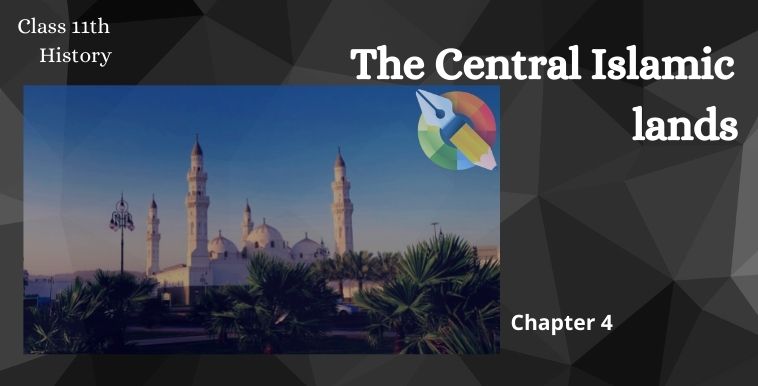This post is a precise notes for chapter 4 The Central Islamic Lands of class 11th CBSE by Vibha Maam. So, read, bookmark it and share with your friends.
Faith, Community and Politics
Mohammad was an Arab and by profession, he was a merchant. Around 612 Mohammad declared himself as the “Messenger of God (Rasul)”. Mohammed was to found a community of believers (umma) bound by a common set of religious beliefs. He preached the worship of a single god Allah. Those who accepted the doctrine were called Muslim. Umma was a single community of believers of Islam.
- Arab culture was largely confined to the Arabian Peninsula and southern Syria and Mesopotamia by the 6th century.
- The Arabs were divided into tribes (Kabila) and each tribe led by a chief of his family.
- The Arab tribes were made up of clans and worshiped an idol (Sanam) in a shrine.
- Many Arab tribes were nomadic( Bedouins). Some were settled in cities and practiced trade and agriculture.
Mohammed belonged to the Quraysh tribe and lived in Mecca and controlled the main shrine kaba (a cube like structure).
- The Kaba was considered a holy pilgrimage where idols of different tribes were placed. It was located on the trade route between Yemen and Syria.
- Arab tribes were making annual pilgrimages(Hajj) to the shrine. Around 612 Mohammed declared himself as the messenger of God. He commanded to preach that Allah is supreme God. Allah alone should be worshiped.
- Affluent Meccans took offense at the rejection of the deities and saw the new religion a threat to the status and prosperity of Mecca.
- In 622 Mohammed was forced to migrate with his followers to Madina. This journey of Mohammad from Mecca to Madina called Hijra and marking the beginning of the Muslim (Islamic) calendar Hijri.
The survival of Islamic Religion
The survival of Islamic Religion consolidation, protection and political institutions are required to survive a community of believers.
- In madina, Mohammad created a political order for the protection of his followers.
- The Umma was converted into a wider community to include polythesis and the jews of Madina.
- The community survived on agriculture, trade and alms tax( zakat).
- Mohammed added some rituals like fasting and ethical principles to consolidate the faith for his followers .
- The Muslims organised expeditionary raids on Meccan caravans. These raids caused a series of battles between Meccan and Madina’s Jews.
- At last Mecca was captured by Muhammad. After that, his reputation spread far and wide as a religious preacher and political leader.
- After Mohammed’s achievements many tribes (mostly Bedouins) were impressed and joined the community by converting to Islam.
- Mohammad’s alliances began to spread until they embraced the whole Arabia. Madina became the administrative capital of the Islamic state and Mecca as the religious centre.
The Caliphate
Expansion ,civil wars and sect formation
After Mohammed’s death in 632, political authority was transferred to the umma. This created the caliphate, in which the leader of the community (Amir-al-mu’minin) became the deputy (Khalifa) of the Prophet. The first four caliphs (632-61) justified the powers.
The two objective of Caliphate:
- to retain control over the tribes
- to raise resources of the state.
After the death of Muhammad, many tribes broke away from the Islamic States.
- The first caliph- Abu Bakr– suppressed the revolts by a series of campaigns.
- The second caliph- Umar, shaped the Umma’s policy of expansion of power. They conquered the Byzantine Empire (Christianity) in the west and the Sasanians Empire (Zoroastrianism, religion of Iran) in the east, through wars and treaties. in three successful campaigns (637-642) the Arabs brought Syria, Iraq, Iran and Egypt under the control of Medina.
- The third caliph- Uthman (Quraysh) -launched the further campaigns to extend the control to Central Asia. the Arab Islamic state control the vast territory between Nile and oxus, within a decade of the death of Muhammad.
New Administrative Structures of Uthman
- The caliph imposed a new administrative structure headed by governors (amirs) and tribal chieftains (Ashraf).
- The government obtained revenue from taxes and raids.
- Most Bedouins were the soldiers of caliphs, settled in camp cities such as Kufa and Basra.
- The ruling class and soldiers received monthly payments (ata). Kharaj and jizya (taxes) were imposed on non-Muslims.
- Jews and Christians were declared protected subjects.
- Uthman (Quraysh of Mecca) packed his administration with his relatives to secure greater control, but it created conflict with the other tribesmen in Iraq, Egypt and Madina also. This led to assassination of Uthman.
- The fourth caliph- Ali – fought two wars against the Meccan aristocracy.
- Ali established himself at Kufa and defeated Mohammed’s wife (Ayesha) army in the battle of camel (657) but failed to suppress Muawiya.
- The second battle of Ali at Siffin ended with the treaty as a result Ali’s followers split into two groups. Some were loyal and some were against him (kharjis) who assassinated Ali at Kufa’s mosque.
- Muawiya made himself the next caliph in 661 and established the Umayyad dynasty which lasted till 750.
The Umayyad dynasty and the centralisation
- Muawiya, the first Umayyad caliph, had shifted his capital to Damascus and followed the Byzantine Empire’s administrative manners.
- He also introduced hereditary succession and followed 90 years in power and the Abbasids retained power for 200 years.
- The Umayyad state was based on imperial power directly by supporting Syrian troops.
- There were Christian advisors zoroastrian scribes and bureaucrats in the administration. but Umayyads always appealed for unity and suppressed rebellion in the name of Islam and also retained their Arab identity.
- Abd-al- Malik adopted Arabic language for administration and Islamic for coinage.
- Greek and pahlavi (language of Iran) were removed from the gold Dinar and silver dirham.
Dome of the Rock in Jerusalem was an example of the great contribution of development of Arab Islamic identity.
The Abbasids Revolution
- Abbasids replaced the Umayyads in 750, through a well organized movement ‘dawa’.
- The Abbasid uprising broke out in the Khurasan (eastern Iran).
- Khurasan had a mixed Arab-Iranian population which could be mobilized for various reasons.
- The Arab soldiers were mostly from Iraq and enraged by the dominance of the Syrians.
- The civilian Arabs of Khurasan resented by the fake promises of tax concessions and privileges of Umayyads.
- The Iranian Muslims (Mawali) were disgraced by Arabs race conscious.
- The Abbasids were descendants of Arabs (the prophet’s uncle)
- They got support from the various dissident groups.
- A Iranians slave, Abu Muslim led their army and defeated the last Umayyad caliph,Marwan in battle at the river zab.
- Arab influence declined while the importance of Iranian culture increased, under Abbasids rule.
- The Abbasids established their capital at Baghdad.
- The army and bureaucracy were reorganised on a non-tribal basis. The Abbasid rulers strengthened the religious status and functions of the Caliphate. but they were forced by the needs of the government to retain the centralised nature of the state.
Break-up of the Caliphate
- The Abbasid state became weaker from the 9th century because of uncontrol over provinces and conflict between pro-Arab and Pro-Iranian.
- A civil war broke out between Amin and Mamun’s supporters in 810.
- Abbasids power was limited to Central Iraq and western Iran.
- When the Buyids (a shiite clan) captured Baghdad.
- The Buyids rulers assumed the title ‘Shahenshah’ (King of kings) not caliph.
- Another Shiite dynasty, the Fatimids(descendant from the prophet’s daughter, Fatima) conquered Egypt in 969 and established the fatimid Caliphate and made her capital Qahira (Cairo).

Unity in Islamic Society
- Between 950 and 1200, Islamic society was held together by common economic and cultural patterns.
- Separation between state and society
- All were free to move within Islamic land and express their ideas.
Rise of Sultanate
- The Turkish sultanate rose in the 10th and 11th century.
- The Turks were Nomadic tribes and skilled warriors and loyal slaves.
- They entered the Abbasid and Samanid, and Buyid administration as slaves and soldiers.
- The Ghaznavid sultanate was established by Alptegin (961) and expanded by Mahmud of Ghazni (998-1030) Khurasan and Afghanistan were the center of power.
- The Saljug Turks (soldiers) entered the Samanids and Qarakhanids under the leadership of Tughril and Chaghri Beg.
- The Saljug conquered Khurasan in 1037 and made his first capital Nishapur.
- Tughril was succeeded by his nephew Alp Arsalan.
Let us know what do you guys think about it, in comment section below.
Stay tuned for more amazing post & articles like this.
Visit Canva to create beautiful images.










i must say you did a great analysis before writing notes
Explicit notes, wow
Wow notes maam,
[…] NCERT Class 11th Chapter 4 History The Central Islamic Lands notes by Vibha Mam CBSE | English […]
thanks for the notes mam